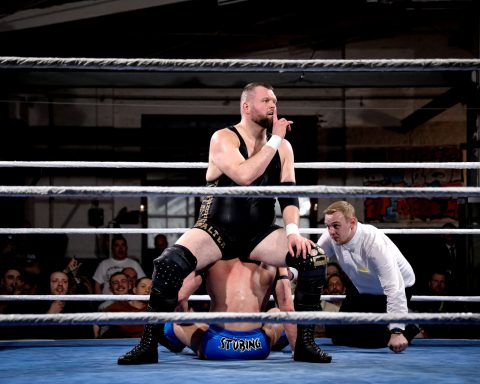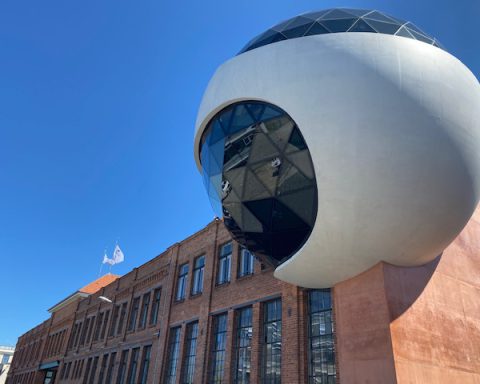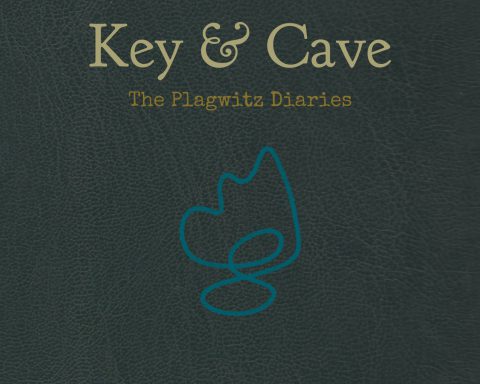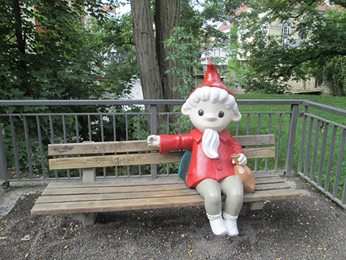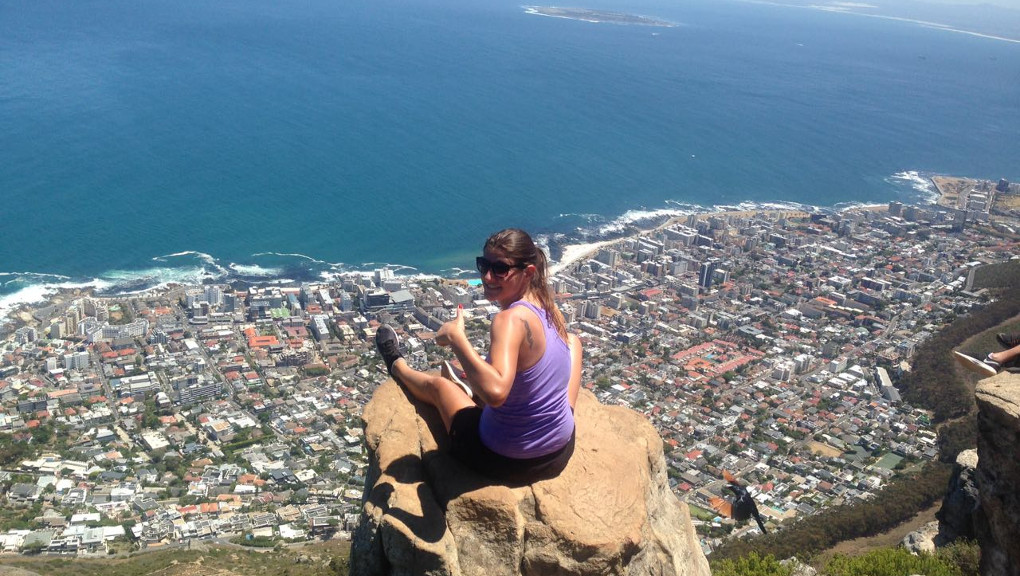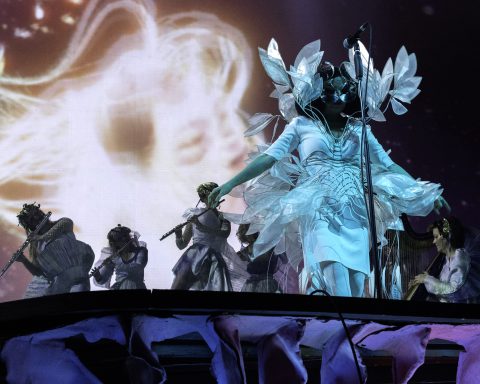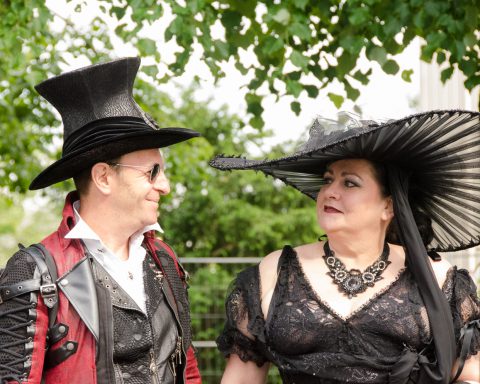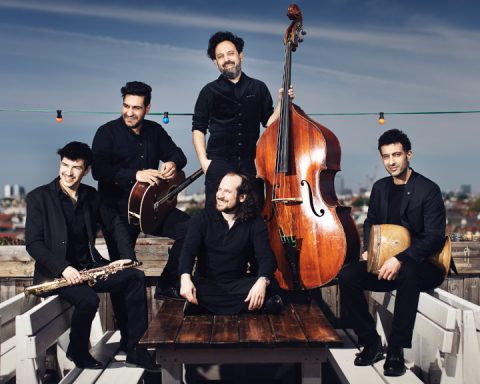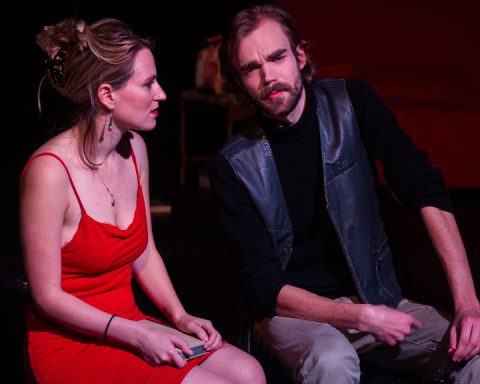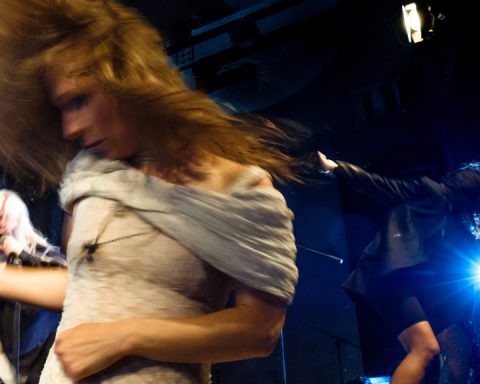Noch Besser Leben is something of a social hub for the night owls of Plagwitz. This bar is known locally for hosting secret shows of touring bands, buzzy gigs of local bands, live comedy sometimes, guerilla open mics, a nocturnally accessible cigarette machine, a dawn-rise closing time, and dead-end drinking sessions. Noch Besser is the inevitable destination when one is too deep in the evening to be welcome at other doors. Neon welcome sign outside spells “Keine Sorge” in pink Cadillac font.
Tonight, I’m at the corner of the downstairs lounge holding a black tea and three international phone numbers. These belong to the three respective limbs of gloom-pop supergroup Owl-Eye-Ring. The band are returning to Leipzig to play a free show, here at Noch Besser, on the 1st of March. It’s the first of eight dates the band will play on this tour, and the announcement was accompanied with the release of a live music video: performing in black and white a solemn rendition of the Smiths’ “There is a Light that Never Goes Out.”
—
Gus: Last year we covered The Cure, we covered “Lovesong.” We’re huge fans of that kind of music.
Demian: We really bonded over bands like the Smiths and The Cure.
Gus: I think we have the same darkness.
—
The name Owl-Eye-Ring may sound familiar to fans of Swedish songwriters Adora Eye and Gus Ring, or the dark-folk duo She Owl. The latter, the primary musical vehicle for Italian musicians Jolanda Moletta and Demian Endian, is notable for having released a body of consistently creative music, influenced by Björk and PJ Harvey, and culminating in what I felt to be their deepest and most complete work to date last October, with Drifters.
In the year that has passed since Owl-Eye-Ring last played in Leipzig, there have been significant changes.
Adora Eye has moved on, but the remaining three members have relocated and are now based in Halle. Leipzigers tend to see Halle as the curious wallflower-next-door who likes tennis and never comes to parties, but this is where the Jackalope artist management team are based. These are the people working with some seriously gifted bands, She Owl for example, and the impressive post-Siouxie-Sioux quartet, Fabian.
There are rougher Crazy-Horse-shaped diamonds also, like Charlotta’s Burnin’ Trio, and indeed talent from all over Europe. That is not to say that all of the artists on Jackalope’ s roster are making memorable music, but they have the room out there to grow, and it’s around this eclectic Jackalope stable that there is potential for an interesting Halle music scene to emerge.
—
Gus: I’d been working with [Jackalope] for 2 years. They helped me go on tour and it went really well. I was inspired to really commit to music by the example of She Owl. They had been living off their music for a really long time and my job in Sweden was coming to an end, and it would not be possible to stay in my apartment. So, I had to make the decision to move [to Halle] – and now I’m a musician. I never thought that it would be possible.
But how has moving to Halle progressed your music career?
Gus: The biggest difference is that I have much more time now. Before I was always getting exhausted by my work, so all the free time that I had I was putting into music – which just makes you even more exhausted. But now I can focus solely on music, which makes me more creative and gives me a clearer head with which I can plan.
—
With Adora Eye no longer involved, the constituent parts of Owl-Eye-Ring make for two contrasting halves.

She Owl is one side of the equation, Gus Ring is the other. An Owl-Eye-Ring performance is, as Gus describes, a live synergy between these two halves. The band as yet have no original songs. Their set consists of covers, Gus Ring songs featuring She Owl, and She Owl songs featuring Gus Ring.
She Owl is established in the underground, but Gus, a relative newcomer, is still coming into his sound. The 27-year-old Swede spent his teenage years screaming in metal bands before he developed as a songwriter.
—
Do you remember what your first songs were about?
Gus: Yeah I had a tough time at school. I was living at my mum’s place. Most of the songs I was writing were depression-themed songs, just to play for myself.
Now that you’re sharing your songs with hundreds of other people, does that change how you write songs?
Gus: I think I write about the same themes, but I have more experience now with myself and how emotions work.
—
Gus plays rock music on his acoustic guitar. Expansive and riffy songs, but even his most layered work, “Hypnoseas” as an example, is layered no deeper than vocals, acoustic guitar, with some glockenspiel for colour. Percussion and electric instrumentation are entirely absent from Gus’s discography, but their presence is clearly desired and implied in the moments where Gus is striking the body of his guitar like a drum, or rattling a drop-tuned low string to mimic bass. The songs are being limited by the constraints of what Gus can perform live as just one man, even if they are written with the ambition of being brought to life in a rock band context.
Make no mistake, however. Even as acoustic versions of what they should have been, these are well-written songs. “Boredomtapes” has been in my head for a few days now. Its chirpy arrangement and sincere vocal performance recalls happier moments from 1990s-era The Cure, specifically songs of theirs like “Halo” and “Maybe Someday.” Although Gus Ring’s influences can be found from all over that generation of alt-rock, from Soundgarden to Smashing Pumpkins.
—
What do you think of Jeff Buckley?
Gus: I think he makes very honest music, and he is very natural. He has this darkness in his music also. That comes out very strongly in the way he sings, I think.
—

During our conversation, I find Gus to be laid-back and open to sharing.
His enthusiasm for answering my questions betrays an intensity and an ambition to be heard and to be understood. No-one becomes a self-employed musician by accident. He has clearly grafted to get to where he is now and has played over 150 gigs across Europe. Over half of these performances have come in the last 12 months. The man is averaging a live performance every 4.5 days.
I sense also a lot of gratitude in Gus. He’s eager to draw my attention to the strengths of his band mates, eager to delegate platitudes to Jackalope, and to dumb luck. He has a measured humility of an artist in ascendency who still remembers very clearly the days of no trajectory.
—
What were your first impressions when you heard Gus Ring’s music?
Julius: It was in a small room, and I felt his music had a Kurt Cobain feeling to it. I really liked it. Very non-egoistic. No ego.
—
In Adora Eye’s absence, Gus has invited Julius Österberg to join Owl-Eye-Ring on this tour. He’s a fellow Swede. They met at a festival last year, and collaborated that summer on the song “Neroli.”
Julius is also a songwriter, and released his debut album Dödsförälskad last year, but I’d expect his biggest contribution to Owl-Eye-Ring will be on cello. It’s an instrument he’s been paired with since childhood.
—
When was your first musical performance?
Julius: That I remember?
Yeah.
Julius: Probably playing cello in a church, a vague memory. I started playing when I was 4.
Do you feel your approach to playing live music has changed as the years have gone by?
Julius: Absolutely.
What has changed for you?
Julius: It’s not really a question of then and now. I want the kind of feeling I had then, but when I was in music college, I was playing with a lot of pressure. It wasn’t so nice. But when I was younger it was very nice. I want that kind of no-pressure vibe again.
—

Unlike the other musicians in Owl-Eye-Ring, Julius’s background is in classical music.
He cites Bach as one of his biggest influences. Although this will be his first rock performance in Germany, he has played here before as part of an ensemble.
Julius has not met She Owl yet, but he is looking forward to playing with his friend Gus again. They’ll be playing a few warm-up concerts together in Sweden. The two have similar backgrounds and senses of humour, although their stories do diverge at a point. Gus left Scandinavia and chased his dreams to Germany, but Julius chose a different path.
—
What would you be doing if you were not going on this tour?
Julius: Probably just being at home, doing not so much. Being bored probably.
What do you do when you’re not playing music?
Julius: I live in a village, and I’d hang around here… watch porn, masturbate, I don’t know.
Do you live in the gardenhouse where you filmed your YouTube videos?
Julius: Yeah a tiny house. I lived there. I bought a farm so now I live in a [normal] house. But for two years I lived in that tiny house.
Did this change the way you were able to make music?
Julius: I took that step to play music a lot. I used to live in Stockholm, and I had to work so much and I was so tired I couldn’t play anything. I was so tired when I got home. So it was an active choice to move to this lifestyle.
And in those two years, you were able to write your first album.
Julius: Exactly.
What inspires you to make music?
Julius – It’s very different, but it’s like a therapy. I really like lyrics, it’s therepeutical [for me]. At the moment, I’m going in a direction that is more spiritual. On the next record I want more of this spiritual music.
—
She Owl’s Jolanda Moletta and Demian Endian have been making music together in the indie underground for almost ten years.
They’ve released two full length albums, two EPs, and collaborated with Piccoli Animali Senza Espressione and Robin Guthrie from the Cocteau Twins on the underrated single “Summer Returns” in 2015.
The She Owl project is very clearly Jolanda’s vision, accompanied by Demian on guitar, and what makes a song like “Summer Returns” interesting in the context of Owl-Eye-Ring, is hearing how Jolanda’s voice reacts to a non-She Owl context. Her vocal performance on this track has a frail quality that is not often heard in her own music, and it contributes without being the centre-piece. It’s a style I find similar to yet another era from The Cure, their dark watercolour soundscapes like “All Cats Are Grey” and “Homesick”. A beautiful song, but insightful also as to why the She Owl duo – who have just finished a two-month tour of their own music – are keen to collaborate with Gus on this Owl-Eye-Ring project.
—
Jolanda has previously described her approach to songwriting as visionary, or cinematic even. How is this vision affected when you’re collaborating with other people?
Jolanda: Writing with someone else is more about intuition than anything else. You’re not in your head. There’s not much time to be thinking. It’s more in the moment.
Demian: It starts with an idea. We pass it around like a ball to each other until it takes on its own life.
—
That it is Demian who performs lead vocals on the “There is a Light that Never Goes Out” cover is a statement of intent by Owl-Eye-Ring. Demian is a good singer, and not dissimilar in tone to Ian Curtis, but there is no space in She Owl’s music for him to take that centre stage from Jolanda.
It reveals a consciousness among the quartet that they can use this project to explore avenues that are normally closed off to them as individual musicians. The rocker without a band. The cellist in search of fun. The vocalist with all the stage. The sideman without a spotlight. Touring together to show their other sides.
Owl-Eye-Ring / Noch Besser Leben / FREE entry / Thurs, 1 March 2018, 8:30 pm / Facebook event
By Adam Carrington
Adam is a lover, not a writer. He loves adventures, personal space, and making friends over cups of tea. Unfortunately, none of these things are considered to be viable professional vocations. He reads postmodern literature and emails.
Cover shot: Owl–Eye–Ring. Credit: Joshua Reel

